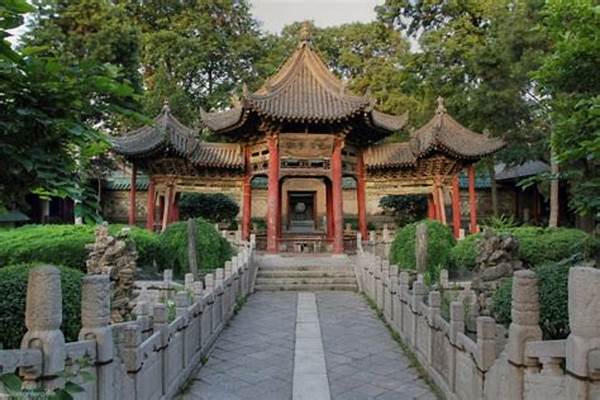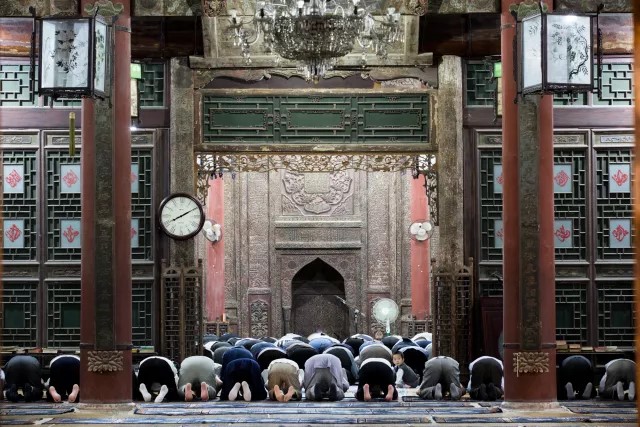
当前课程知识点:陕西导游英语 > 1. 美景篇 > 1.8 The Great Mosque 西安清真大寺 > 1.8 Text 讲解词


Genearl Information
First, let’s go over some basic information about the Great Mosque in Xi’an. Covering over 13,000 square meters, the Great Mosque is located in Huajue Lane to the northwest of Drum Tower. Historians say that it was built in 742 AD in the Tang Dynasty. Yet judging from its architectural style, experts believe it was built in the Ming Dynasty, which means it has a history of at least 600 years. Now the Mosque is not only a major spot for Islamic activities in the city, but also an important historical monument in Shaanxi Province. To tourists, unlike the Arabic mosques with splendid domes, bright colors, and the minarets pointing high into the clouds, the Great Mosque shows many beautiful traditional Chinese buildings, towers, platforms, pavilions and halls.
Major Parts
There are four courtyards. In the first courtyard is the Wooden Memorial Archway . The archway stands about nine meters high, and has a history of nearly 400 years. Serving as a gate for the Mosque, the archway has upturned eaves, many layers of brackets and glazed roof-tiles. It certainly looks magnificent. On both sides of the archway, there are several wing rooms, in which there are old furniture made in the Ming and Qing Dynasties on display.
Through Wujianlou, or the five-roomed hall, there stands a stone memorial gateway in the center of the second courtyard. On top of the main gate of the gateway, there are four characters inscribed in Chinese calligraphy. It says, “the Court of Heaven”. The gateway is flanked by two tall tablets, with dragons carved on each. Both tablets are carved with inscriptions about the repairing of the Mosque at the imperial order in the Ming and Qing Dynasties. The inscribed characters were written by two famous calligraphers. And the calligraphy is regarded as some of the best of art in China.
In the third courtyard is the Imperial Hall. It is the oldest part of the buildings in the Mosque. There is a tablet called “the Crescent Tablet”. The inscription on the tablet is in Arabic. It was written by a late famous imam. The content of the inscription was about the way of the calculations of the Islamic Calendar. Now the stone tablet is a very valuable historical record about the development of Islam in Shaanxi Province. Another important building in this courtyard is called “the Introspection Tower” . It serves as the minaret. It is also the tallest building in the whole mosque. There are two stories, three layers of eaves. On the southern side of the minaret is the Official Reception Hall. To the east of the Official Reception Hall, there is a bathing house for Moslems to wash their body before worship . And on the north side is the minaret is the Lecture Hall, in which a hand-written copy of “the Holy Koran” of the Ming Dynasty and the map of Mecca of the Qing Dynasty are well preserved.
Through three connected doorways decorated with fine brick carvings , we enter the last courtyard. What we see first is “the Phoenix Pavilion”. It is a very special building with a combination of the Chinese traditional archway and pavilion. The pavilion, as the main body in the middle, is shaped in a hexagon with its eaves upturned and its top protruded. The whole architecture seems to be a beautiful phoenix spreading its wings and is about to fly. At the back of the pavilion, there is the 1,300-square-meter prayer hall. It can hold over 1,000 worshippers at a time. The ceiling of the hall is decorated with over 600 pieces of classical scriptures. The walls of the hall, the entrance as well as the panels, are decorated with patterns of trailing plants and Arabic letters. Around the hall inside, all the pages of “the Holy Koran” are carved in the 60 pieces of huge wooden boards, 30 of them are in Chinese, and others in Arabic. They are really marvelous carvings of art, and rarely seen in the other mosques of the world.
Value of the Great Mosque
In the year 1956, the Great Mosque was decreed as an important historical and cultural site under the protection of the Shaanxi Provincial Government. In 1988, it was further promoted to be one of the most important sites in China. Since we had the policy opening and reform to the outside world in 1978, the Mosque has received over 10 million visitors, including Moslem brothers who came from over 100 countries and districts of the world, and many heads of the states and governments. After visiting the Mosque, tourists would surely have a better understanding of the history of the Mosque and the religious life of Moslems in Xi’an.
Moslems in China
Actually, the Moslems in china share very much the same customs with their brothers and sisters elsewhere in the world. They worship five times a day: at dawn, at noon, in the afternoon, at dusk, and at night. Female worshipers attend their services in a separated place from their brothers, usually at home. Moslems pay special attention to their health and see that they always wear clean clothes. They are teetotalers not only of wine, but also of pork and animal blood, for in Koran pigs have been mentioned four times as being “unclean”. According to Koran, a man can have four wives and women should wear veils when they go out. However, the Chinese practice monogamy and women are free of veils when they go out. Upon their death, Moslems has to be first “thoroughly cleaned” (which means thoroughly bathed), then has to be put on to be shrouded with a piece of white cloth and finally has to be buried coffinless in the ground, with an imam reciting scriptures at the funeral.
The Chinese constitution promulgates that freedom of religion of each citizen and freedom of preserving or reforming local customs for every nationality are permitted. And of course, the Moslems in china enjoy equal rights with peoples of other nationalities and their religious beliefs and customs are respected everywhere in the country.
-1.1 Emperor Qinshihuang’s Mausoleum Site Museum 秦始皇帝陵博物院
--1.1 Test 测试
-1.2 Shaanxi History Museum 陕西历史博物馆
--1.2 Test 测试
-1.3 The Forest of Stone Tablets 西安碑林博物馆
--1.3 Test
-1.4 Xi’an City Wall 西安城墙景区
--1.4 测试
-1.5 The Huaqing Hot Spring 华清池景区
--1.5 测试
-1.6 The Big Wild Goose Pagoda 西安大雁塔
--1.6 测试
-1.7 The Tang Paradise 大唐芙蓉园
--1.7 测试
-1.8 The Great Mosque 西安清真大寺
--1.8 测试
-1.9 Famen Temple Buddhist Cultural Scenic Area 陕西法门寺佛文化景区
--1.9 测试
-1.10 The Yellow Emperor’s Mausoleum 黄帝陵景区
--1.10 测试
-1.11 Yan’an Revolutionary Heritage Site 延安革命纪念地景区
--1.11 测试
-1.12 Mount Huashan 华山风景名胜区
--1.12 测试
-1.13 Jinsi Grand Canyon Scenic Spot 金丝峡景区
--1.13 测试
-1.14 Taibaishan International Holiday Resort 太白山国际旅游度假区
--1.14 测试
-2.0 Prelude 引言
-2.1 Diced Pancake Boiled in Mutton & Beef Soup 羊肉泡馍
--2.1 Test 测试
-2.2 Xi'an Dumpling Banquet 饺子宴
--2.2 Test 测试
-2.3 Biang Biang Noodles 扯面
--2.3 Test 测试
-2.4 Pancake Stuffed with Marinated Pork 肉夹馍
--2.4 Test 测试
-2.5 Cold Noodles with Sesame Paste 麻酱凉皮
--2.5 Test 测试
-3.1 Shaanxi Local Specialties 陕西特色手工艺品
--3.1 Test 测试
-3.2 Qin Terracotta figures 兵马俑复制品
--3.2 Test 测试
-3.3 Stele Rubbings and Yaozhou Green ware 拓片和耀州瓷
--3.3 Test 测试
-3.4 Leather Shadow Puppets and Paper Cuts 皮影和剪纸
--3.4 Test 测试
-3.5 Shuyuanmen Cultural Street 书院门
--3.5 Test 测试
-4.1 The Tang Dynasty Music and Dance Show 仿唐乐舞
--4.1 Test 测试
-4.2 The Song of Everlasting Sorrow Evening Show 长恨歌
--4.2 Test 测试
-4.3 The Great Tang All Day Mall 大唐不夜城
--4.3 Test 测试
-5.1 Meeting with a Tour Group at the Airport 机场接机
--5.1 Test 测试
-5.2 Welcome Speech 欢迎词
--5.2 Test 测试
-5.3 Brief Introduction to Shaanxi and Xi’an 陕西及西安简介
--5.3 Test 测试
-5.4 On the Way to the Hotel 去钟楼饭店途中
--5.4 Test 测试
-5.5 Check in at Bell Tower Hotel 钟楼饭店入住
--5.5 Test 测试
-5.6 Discuss the Itinerary 讨论行程安排
--5.6 Test 测试
-5.7 Change the Room 调换房间
--5.7 Test 测试
-5.8 Arrange the Morning Call 安排叫早
--5.8 Test 测试
-5.9 On the Way to the Scenic Spot 去景点途中导览
--5.9 Test
-5.10 Having a Meal 用餐
--5.10 Test 测试
-5.11 Watching the Song of Everlasting Sorrow Evening Show 看《长恨歌》实景演出
--5.11 Test 测试
-5.12 Shopping 购物
--5.12 Test 测试
-5.13 Check Out 结账离店
--5.13 Test 测试
-5.14 Seeing the Tourists Off 机场送别
--5.14 Test 测试
-期末考试